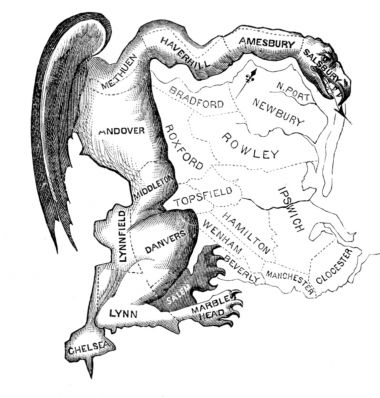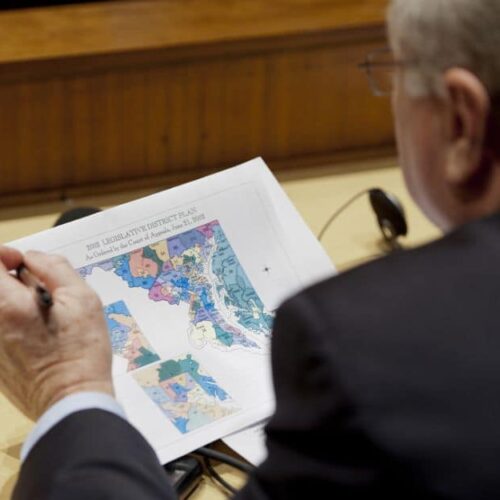Introduction
State legislative races attract little or no national attention on a typical Election Day. But toward the end of each decade, they rise to national prominence. That’s when voters, in the vast majority of states, elect those who will redraw boundaries for congressional districts.
This is one of those years. Voters will decide on more than 6,000 state House and Senate seats nationwide Nov. 6, determining which parties control their state legislatures for the next two or four years. Whichever party holds the majority in each state after the 2020 census results are finalized will therefore control that state’s maps through 2032.
Those who draw the districts have a tremendous impact on which party will hold the majority in the U.S. House of Representatives. So national political groups and even out-of-state donors are trying to sway this year’s state races that will shape the political landscape for the whole country.
The nuts and bolts of redistricting vary by state, but elected legislators run the process in 37 states. The seven states with small enough populations to have only one U.S. House seat — Alaska, Delaware, Montana, North Dakota, South Dakota, Vermont and Wyoming — don’t need to worry about the congressional mapping.
Governors also hold veto power over legislatures’ congressional maps in 35 states, and attorneys general help draw the congressional lines in two states — Mississippi and Texas — adding to the list of races targeted in the fight over partisan redistricting.
Several states, though, hand their redistricting responsibilities to independent commissions such as citizen councils or demographers. A growing movement is calling for more of those commissions nationwide to remove partisan line-drawing from the political arsenal. And voters in some states this fall will be asked to weigh in.
The court system is also playing a role, with even the U.S. Supreme Court taking on the issue.
A decade ago voters did not respond to redistricting as a campaign issue, but this time they are getting involved, according to Michael Li, senior counsel at New York University School of Law’s Brennan Center for Justice, a nonpartisan center that advocates for voting rights.
“The thing about redistricting is that there’s a lot at stake,” Li said. “There certainly is just an incredible level of energy around this issue.”

United States public domain
A history of partisanship
Redistricting became so contentious because of the notorious “gerrymander,” in which a political party draws convoluted maps to favor an incumbent or a party. The term dates back to an 1812 district map accepted by Massachusetts Gov. Elbridge Gerry.
Yet some scholars argue that Patrick Henry was behind the first gerrymander more than 20 years earlier in an attempt to keep James Madison out of Congress.
“Even the framers engaged in political shenanigans,” Li said. “We’ve always had some kind of political manipulation of districts as long as there’s been a country.”
The phenomenon has picked up speed much more recently.
Democrats successfully gerrymandered in the 1970s and 1980s when they held more power, but political parties now have access to advanced data that allows for the drawing of even more partisan maps. It’s now Republicans who, in the past decade of legislative dominance, have used redistricting with great efficiency.
A 2015 study published in the University of Chicago Law Review by Nicholas Stephanopoulos of the University of Chicago and Eric McGhee of the Public Policy Institute of California found the plans in effect today are the most extreme gerrymanders in U.S. history.
The major redistricting tactic is called “packing and cracking.”
If the Republicans were to draw the maps, for example, they would pack Democratic voters into a few heavily blue districts and then crack the remaining Democratic voters in districts that would swing red.
A relatively new measurement created by Stephanopoulos and McGhee called the “efficiency gap” quantifies the impact of this strategy by counting votes cast for losing candidates and those beyond what was necessary for the winner.
North Carolina offers perhaps the starkest example. While Republicans won 53 percent of votes across the state in the 2016 U.S. House elections, the party claimed 10 of the 13 seats.
Judicial challenges
Now those district lines in North Carolina appear short-lived. In the court case Common Cause v. Rucho, a federal three-judge panel ruled in January and again in August that the state’s congressional districts must be redrawn, although not until after November’s critical elections.
Two other cases, one in Maryland and one in Wisconsin, are working their way through the court system. Experts predict the North Carolina case to be the one heard by the U.S. Supreme Court in the current term, in no small part because it involves a member of the Legislature publicly acknowledging that the maps were drawn for political gain.
“I propose that we draw the maps to give a partisan advantage to 10 Republicans and three Democrats,” Republican state Rep. David Lewis said in a 2016 public hearing on redistricting.
Dan Vicuña is the national redistricting manager of Common Cause, a nonprofit group advocating for redistricting reform. He said Common Cause members expect the group’s namesake court case to be heard by the Supreme Court.
“We’re looking for a ruling that says partisan gerrymandering is unconstitutional, and that will make it easier to sue on other maps on which politicians discriminate against voters,” Vicuña said.
Independent answers to an old issue
The Nov. 6 elections could usher in significant changes with ballot measures aimed at amending the redistricting process in four states.
If approved, those would hand most redistricting responsibilities in Michigan and Utah to an independent commission, in Colorado to two commissions — one for congressional districts and one for state legislative districts — and in Missouri to a nonpartisan demographer. In both Utah and Missouri, though, the maps would still need approval from members of the legislature.
Voters in Ohio also overwhelmingly approved a legislative referendum in May that keeps the power of redrawing maps with the state Legislature but requires specific levels of bipartisan approval.
Wendy Underhill, who directs elections and redistricting at the bipartisan National Conference of State Legislatures, said there is a growing shift toward independent commissions and other alternative methods of redistricting.
“It’s been one or two states changing every decade, and what’s new and different this time is the number of ballot measures both from the legislatures and from citizens is greater this year than from 2011 through 2017,” she said.
More are already planned. In one case, the Arkansas attorney general certified the title and language of a ballot initiative in May to create an independent commission, but it was not finalized in time and will have to wait for the 2020 elections.
A group in Oklahoma called Represent Oklahoma aimed to have a similar proposal on this year’s ballot but also will have to wait.
Already, six states — Arizona, California, Hawaii, Idaho, New Jersey and Washington — divide up their congressional districts with some form of commission that has strict rules on party representation.
Common Cause led the push for California’s independent commission and has been working to do so elsewhere. To drum up support from both sides of the aisle, Vicuña said the organization highlights how fickle the political tides can be, noting Democrats behaved “just as badly as some of the worst Republican gerrymanderers” in other parts of the country.
“We’re always quick to remind people that you’re never sure what party’s going to be in charge,” he said.
“We’re always quick to remind people that you’re never sure what party’s going to be in charge.”
Dan Vicuña, national redistricting manager, Common Cause
Even those bipartisan commissions are not totally immune to politicking, though, as Arizona recently experienced a largely partisan fight over an attempt to amend the rules governing its independent commission.
And not all efforts to create new systems succeed. A 2016 ballot measure to create an independent commission of registered voters to draw state legislative districts failed in South Dakota, for example.
Who foots the bill?
The Brennan Center’s Li said the push for more nonpartisan redistricting has been a “grassroots movement,” including in Michigan where a single Facebook post helped spark the current ballot initiative.
“There is today a pervasive sense among many people that the system is broken, that the system is rigged,” Li said.
But out-of-state interests have jumped into the fray, as well, with mega-rich donors and the national parties opening their pocketbooks.
In the case of the Michigan ballot initiative, for example, state campaign finance reports show the Action Now Initiative, a progressive advocacy group working with Texas billionaires Laura and John Arnold, gave at least $262,000 to the committee pushing the ballot measure. The Arnolds have also spent heavily in other states facing redistricting initiatives, including Missouri where they’ve already donated more than $1 million.
“We believe that all citizens deserve a government that is open and accountable to the people, and we are proud to support grassroots initiatives across the country that seek to increase integrity, responsiveness, and accountability from our elected representatives,” Action Now Initiative CEO Sam Mar said in an emailed statement.
(Laura and John Arnold are donors to the Center for Public Integrity. More details on our funders.)
On the other side, a group called Citizens Protecting Michigan’s Constitution filed an unsuccessful complaint in state court in April to have the initiative thrown off the ballot. A $50,000 contribution made to the committee came from a new group called Fair Lines America Inc. that lists the same mailing address, a P.O. box in Alexandria, Virginia, as other conservative donors.
Citizens Protecting Michigan’s Constitution and Fair Lines America Inc. did not respond to requests for comment.
The national parties have also thrown their weight behind local races that might flip state legislatures or governors’ mansions in the interest of redistricting.
Former Attorney General Eric Holder formed the National Democratic Redistricting Committee in early 2017 to organize the Democrats’ redistricting efforts. The group is targeting ballot initiatives and races in 12 states with the goal of influencing the upcoming redistricting. Data from the IRS shows the committee reported spending more than $5 million during the first half of this year. And in September, the group announced it would inject $250,000 into the effort to pass the Michigan ballot measure.
The GOP responded with the formation of the National Republican Redistricting Trust, which is staffed by veteran Republican operatives and shares its mailing address with the group that helped fund the attack on Michigan’s independent commission ballot measure. Trust officials have told several media outlets that they plan to raise $35 million by 2020.
With many governors holding the power to veto maps, the parties’ governors associations are also spending big on the elections.
On Sept. 18, the Democratic Governors Association announced it and related groups spent or earmarked $40 million for elections in nine states as part of its “Unrig the Map” project, which takes aim at what it labels unfair districts.
“We have the opportunity this cycle to deliver a devastating blow to the pernicious and undemocratic scourge of gerrymandering,” the group’s chair, Washington Gov. Jay Inslee, said at the time.
In April, the Republican Governors Association announced its total spending had increased to $34 million in 10 gubernatorial elections. In a number of media outlets, the association’s spokesperson has stressed the importance of those elections to Republicans’ holding onto the U.S. House.
The National Democratic Redistricting Committee, the National Republican Redistricting Trust, the Democratic Governors Association and the Republican Governors Association did not respond to requests for comment.

Legislating to change
Another response to redistricting has been to try to push legislation to take the political partisanship out of the equation.
In February 2017, U.S. Rep. Zoe Lofgren, D-Calif., introduced the Redistricting Reform Act that would require every state to set up an independent commission. “Too often, politicians choose their voters instead of voters picking their elected officials,” Lofgren said in a statement at the time.
But the bill is stuck in a congressional subcommittee.
So with this and other redistricting bills failing to gain traction in Congress, the issue remains in the hands of the states.
Lawmakers nationwide have introduced more than 100 bills over the past two years that address redistricting, according to research from the Brennan Center and the National Conference of State Legislatures. Often the bills call for independent or bipartisan commissions.
Some of those efforts will likely come to a vote in the next several years, either as pieces of legislation or as ballot measures.
In March, the nonprofit OneVirginia2021 launched a 10-month campaign to demand the Virginia General Assembly enact a constitutional amendment ending partisan redistricting. The state has its next major legislative elections in 2019.
In Pennsylvania, a coalition of citizens groups called Fair Districts PA is pushing state politicians to act on several bills that would create an 11-member redistricting commission via an amendment to their constitution. Votes by the Legislature in two sessions as well as a voter referendum are needed to approve the amendment.
But the likelihood of those legislative measures passing depends in part upon who wins the state elections.


Join the conversation
Show Comments